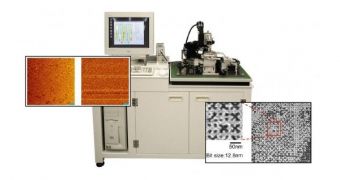Hard drive storage seems to be losing ground to solid state drives, which are faster and more reliable, albeit not on par with the former in terms of capacity, but a team from Japan's Tohoku University have just made progress in their research into ferroelectric storage, a technology that can cram very high data densities into small physical volumes.
By using a pulse generator, the Japanese researchers were able to modify the electrical state of tiny dots on a ferroelectric medium, and this let them hit a data density of 4 trillion bits per square inch.
This procedure is, as one may guess, quite complicated, at least compared to the ones used in today's storage solutions.
In order to perform this feat, Kenkou Tanaka and Yasuo Cho used, as a storage and playback device, a Scanning Nonlinear Dielectric Microscope.
Basically, this device sent relatively large voltage pulses through a pulse generator to a Lithium Tantalate medium of 30nm.
The result was that the electric polarization and nonlinear dielectric constant of the aforementioned tiny spots were set to either positive or negative, corresponding to a “1” data bit and “o” bit, respectively.
The two scientists also developed a method for reducing the incidence of miswritten dots by experimenting with multiple pulse amplitudes.
Basically, the team believes that ferroelectric storage will eventually replace magnetic hard drives and flash memory, at least in fields that prize small physical volume and high densities.
Unfortunately, there was no word on how long it will take for this technology to actually spawn commercially-viable products, so evey-day end-users will still have to weigh between HDDs and SSDs when browsing through stores, online or otherwise.
"We expect this ferroelectric data storage system to be a candidate to succeed magnetic hard disk drives or flash memory, at least in applications for which extremely high data density and small physical volume is required," said Dr. Yasuo Cho.

 14 DAY TRIAL //
14 DAY TRIAL //